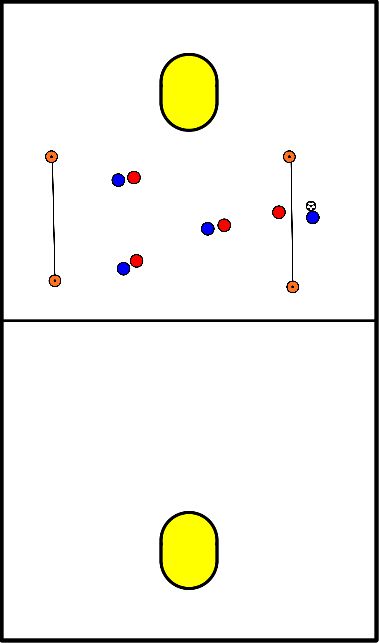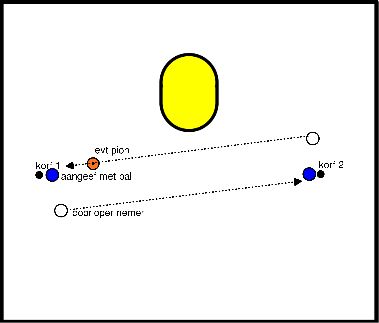Korfball drills
Task:
- Who is the first to circle the ball or the player?
Rules:
- Everyone stands in a circle with enough space to throw a ball quickly.
- The ball starts to the right of the child who is going to run.
- The child who is going to run, runs at the same time as throwing the first ball on the outside of the circle.
- Player 1 starts at 6 meters from the basket.
- Player 2 stands between player 1 and the basket at 2 metres from player 1.
- Player 1 starts running for a through ball.
- Player 2 has to prevent the through ball.
- So player 2 must bend his knees to be able to move immediately.
- Also, the player must move immediately when player 1 starts to run.
- If this is not done, you are too late and you will never catch up with player 1.
- The goal is to prevent the walkthrough ball.
- You stand on a large field.
- You make 2 teams 1 team stands left behind the line and the other team right behind the line.
- 1 big ball, lies in the middle of the field.
- Each player has a ball.
- They try to hit the ball from behind the line and roll it over the line of the opponent.
- After throwing you pick up your own ball and stand behind your own line again, and you start aiming at the big ball again, until the ball has crossed someone's line.
- Players run/dribble around a set square. (poles/pawns, sufficient distance from each other).
- Players are given a list of commands in advance, with a corresponding number.
- The trainer calls out a number randomly, players carry out the assignment.
- You can adjust the number of missions and the missions themselves.
- Example of assignments.
- Tapping the ground.
- Jump in the air.
- Sprint to the next pole.
- 1 burpee.
- Backwards as if you are defending until the next pole/pawn.
- Everyone in a circle or whatever.
- Pass the ball around by throwing with two hands.
- Pay special attention to the technique of throwing the ball.
- When this has been done a few times you can switch styles, so for example with one hand.
- Or perhaps above the head.
- Alternate in this.
Objective:
Set up attacks in overtime situations
Rules:
- Make sure the offense always has 1 more person than the defense (3-2, 4-3, 4-2 etc.)
- Gives the offense a task:
- E.g. score within 5 passes, score after setting up an action, score from the rebound.
- Gives the defense a task:
- E.g. intercept the ball within 5 passes, defend in front.
- Decide if you can go for a defensive goal.
- Indicate with cones where the lines are.
- Agree when offense switches with defense:
- After X minutes, after X goals, after X interceptions.
Three warm-up exercises for flexible muscles.
These exercises are for back, back and hamstring and back legs, ankles and arms.
- Dangling pose. (back)
- Both feet hip-width apart with feet forward.
- Hands go up sideways.
- Tilt your pelvis forward and bring your hands to the ground.
- Try to feel the breath in your back and hold for 1 minute.
- Then come up at a slow pace, vertebra by vertebra.
- Down dog. (hamstring and back)
- Hands and knees on the ground. (Hips above the knee and hands straight under the shoulder))
- Plank on your hands.
- Backside up and back, leaving hands where they are.
- Hold for 20 seconds and then back in reverse.
- Triangle pose. (back, legs, ankles and arms)
- Stand arms and legs wide apart. (Legs at wrist width)
- Turn right foot 90 degrees to the right and point left foot forward.
- Ankles stay in 1 line.
- Reach to the right and move your right hand to your calf and look up at your left hand. (Arms stay at 180 degrees)
- Hips stay forward.
- Stand still and come up.
- Exercise 1 and 2 we do 3x, exercise 3 left and right.
- On the field, place x number of hats at random spots, half on his point.
- You play with 2 teams of 1 or more players.
- Party A puts the hats on the point party B puts them the other way around.
- After x minutes stop and count who has the most hats.
Objective:
- Earn a point by catching the ball over the line.
Rules:
- A party starts from behind the line with the ball.
- Intercepted ball is ball first to your own line and then to the other side for a point.
- Balls out count.
- When a point is gained, the opponent gets the ball from there.
Points of attention:
- For defending.
- Play on the side by moving on one leg.
- Play at tempo.
- Watch each other and your opponents place.

- 1 attacker keeps shooting while keeping the balloon high (so it doesn't hit the ground)
- The catcher catches and throws the ball.
- You need 2 baskets per 4 or 5 persons.
- The poles are opposite each other.
- There are fixed helpers with the ball.
- You take the run-through on the post opposite the post where you started.
- When you have made the run through, you start again from the pole where you just made the run through and continue to the other side.
- Change after x goals or after so many minutes.
- Then the passers take the runners and the takers pass to the other players.
- Pay attention to the passing and the technique of the runthrough.
- If necessary, put a cap or a pawn where the children should get the ball.

- Make a circle at the level of your head on the wall (with sidewalk chalk)
- Make the circle about the same size as a basket.
- Now stand 3 or 4 meters away from the circle.
- Now throw the ball with your left against the wall and catch it with your right hand.
- Do this for one minute.
- The ball must not bounce on the ground.
- If it is too easy, stand further away or try to throw the ball faster. If the exercise is too difficult, try to catch the ball with two hands, but still throw with one hand
- Or stand a little closer to the wall. (Outdoors exercise)








